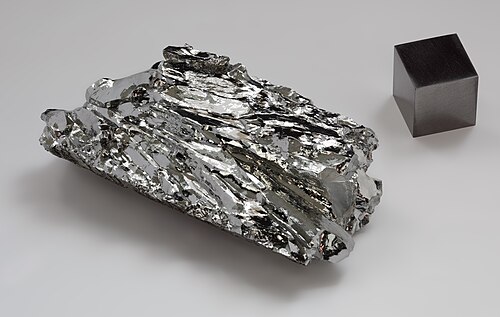Facts for Kids
Molybdenum is a chemical element with the symbol Mo and atomic number 42, known for its high melting point and strength, making it valuable in various industrial applications.
Overview
Fun Facts
Biological Role
Chemical Properties
Physical Properties
Environmental Impact
History And Discovery
Uses And Applications
Occurrence And Production

Inside this Article
Carl Wilhelm Scheele
Cubic Centimeter
United States
Melting Point
Nitrogen
Addition
Valence
Alloy
Land
Did you know?
🔩 Molybdenum is a silvery-white metal that is notable for its high melting point, around 2,623°C (4,753°F).
⚙️ It is primarily used as an alloying agent in steel production to enhance strength and resistance to wear and corrosion.
🧪 Molybdenum is essential for the growth of some plants, as it plays a crucial role in nitrogen fixation.
🌍 Molybdenum is primarily mined in countries such as China, the United States, and Chile.
🚀 The metal's high resistance to heat makes it valuable in aerospace applications, particularly in jet engine components.
💎 Molybdenum has the lowest thermal expansion coefficient of any metal, making it useful in high-precision instruments.
🔬 It is also used in electrical contacts, filaments, and other high-temperature applications.
🌡️ Molybdenum can withstand temperatures that are significantly higher than those that can be handled by most other metals.
🔄 Recycling of molybdenum is common due to its high value and the significant energy savings compared to fresh mining.
⚠️ Molybdenum exposure in excessive amounts can lead to health risks, particularly in industrial settings.
Introduction
️ It is found in a group of metals called transition metals, which are known for being strong and durable. Molybdenum is usually mixed with other metals to make them stronger, like steel, making them even more useful. This metal is also very important in making tools and equipment because it can resist heat and wear. Molybdenum is found all over the world, especially in countries like the USA, China, and Chile. 🌎
Fun Facts
Did you know that molybdenum is used in luxury watches and some high-end electronic devices? Those shiny metal parts may be made from molybdenum! Additionally, molybdenum is a key part of the alloy which is used in rocket engines because of its ability to withstand extreme temperatures. 🚀
It’s even used in some special dishes and cooking utensils! Molybdenum is also one of the "Super 7" minerals in geology, making it a fascinating study for scientists and enthusiasts alike!
Biological Role
Some tiny organisms, like bacteria, need molybdenum in small amounts to grow. Molybdenum helps these bacteria process nitrogen, which is a vital nutrient for plants. 🪴
Plants take up molybdenum from the soil, and when animals eat plants, they also get some molybdenum in their diet. While it’s needed in very tiny amounts, too much molybdenum can be harmful, showing us how important balance is in nature!
Chemical Properties
This means that in chemical reactions, molybdenum behaves like other transition metals. It has six valence electrons, which helps it bond with other elements. One cool fact is that molybdenum can form different compounds. For example, when molybdenum combines with sulfur, it creates molybdenum disulfide (MoS₂), a shiny black solid used as a lubricant! It doesn’t react with water or air easily, which is why it can be found in nature as a pure metal.
Physical Properties
It has a sturdy density of 10.28 grams per cubic centimeter, making it heavier than aluminum or iron. Molybdenum is usually formed into rods, sheets, or wires for various uses. When heated, it glows bright red, but at room temperature, it looks like a shiny silver metal! Its hardness is about 5.5 on the Mohs scale. 🔧
Environmental Impact
Improper mining practices can harm nearby land and water sources. However, moody mining practices have improved to protect the environment. Molybdenum can actually help in environmental efforts! 🌱
For example, adding it to fertilizers can improve soil quality, helping plants grow better. Scientists are constantly looking for ways to minimize the negative effects of molybdenum on the environment while maximizing its benefits in agriculture and industry.
History And Discovery
He found it while studying a mineral called molybdenite. Later, in 1781, another chemist named Peter Jacob Hjelm isolated molybdenum from its ore, giving us pure molybdenum! The name "molybdenum" comes from the Greek word "molybdos," meaning lead. It wasn't until the 19th century that molybdenum started being used in making steel and other materials. 🏭
Since then, scientists have learned how valuable this metal is for many modern applications.
Uses And Applications
One of its main uses is in making steel. When added to steel, it helps it become very strong and heat-resistant, which is perfect for tools and construction materials. Molybdenum is also used to create electrical contacts and lightbulb filaments! 💡
In addition, it plays an important role in the aerospace industry, helping to build airplanes and rockets. Lastly, molybdenum is vital in making some types of clocks and watches!
Occurrence And Production
The main places where molybdenum is mined include the United States, China, and Chile. Did you know that molybdenum is extracted from its ores through a process called roasting? In roasting, the ore is heated in the presence of oxygen to release pure molybdenum! After extracting it, it is often processed to make it purer before being used in different materials. Mining sites, like the Climax Mine in Colorado, are important for getting molybdenum!

